
Dart Games and Rules - Games to Play on a Standard Dartboard
Dart games you can play on a standard (London Clock) dartboard
![]()
Darts is a sport enjoyed by all, regardless of age or gender. People play for fun, while others take this sport very seriously. There are many games to play, the most common is the ’01 game , followed by ‘Cricket.’ I call it American Cricket because it has no reference to wickets, bats, balls or runs. Shanghai is probably the third most commonly played dart game around the world. However, there are a lot of games for you to enjoy. Some are designed for the not-so-skilled, while others require much skill to play well.
I have gathered a list of familiar dartboard games and rules for you to enjoy. They include the standard ’01 games, Cricket played widely in America and Asia, Shanghai, Prisoner and Half-it, to name just a few. I have also added a few of my own. The Grand National is a game that anyone can play regardless of their standard of play. One of my favourite games is 180 Around the Clock! This game can be used just to help you improve your accuracy or play with several people. I leave you to explore the rest.
There are different online casino games that are related to darts. Go to the arcade section of the casino you like and check out all games they have. For example pick Darts 180 made by 1x2 gaming.
When looking for casino games that are Darts related, arcade games might be right for you. If you are a South African player, then sites like online casino games, South Africa can help you find the right spot. New Zealand players should look for online casino games NZ or use a google search to find the right place. Nowadays, you can also play Bitcoin casino games USA, to play with bitcoin or other crypto currencies. It can be safe if you don’t want to use your credit card. Always check your local laws before depositing real money.
Details of some of these games can also be found on a couple of my other dart websites, Darts-Oche.com, Darts01.com and Darts-UK.co.uk.
Dartboard Games
Click to expand
Standard #01 Game
Board Setup

The Board should hang securely from a wall so that the height of the centre bull is 5'8" or 1.73m from the floor.
The throwing distances can vary from anything from 7ft to 8'6" but the standard game is played from 7'9 ¼" 2.37m from the face of the board measured horizontally. For soft tip boards the throwing distance is usually longer i.e. 8’ or 2.43m
The toe-line or Oche shall be clearly marked and should be at least 18" long. The toe line can be just a painted line on the ground or a securely raised line indicator such as a piece of wood or metal. The latter is preferable as the thrower as firm edge to rest his/her foot against.
Steel tip and soft tip darts
Players can use any darts as long as the overall length of 30.5cms. (12") nor weigh more than 50 grams is exceeded. The dart should consist of a needle shaped point, which shall be fixed to a barrel. At the rear of the barrel shall be an attached flighted shaft / stem, which may consist of up to five separate pieces. (IE: a flight, a flight securing device(s), a flight protector, and a stem.) For soft tip darts used on soft tip boards most rules state that no dart heavier than 18 grams can be used otherwise the board can be damaged. Some soft tip boards can take heavier darts up to 24 grams but with heavier darts you do tend to break more tips.
Play
The order of play is either determined by a toss of a coin or by each player throwing for the centre bull the nearest being the player that throws first. The rules here can vary depending on the league you may be playing in; the local rules should be observed at all times.
When throwing for the bull, if the first thrower hits the centre bull or outer bull the dart is usually removed before the second player throws. If the second player hits the same as the first player then the bulling-up procedure starts again. If the first player's dart does not hit either the centre bull or outer bull then the dart remains in the board until the second player throws. If the first player's dart is obstructing the bull the second player may request the marker / ref to straighten the dart. (See local rules)
Once the order of play as been determined the winner will start leg one and odd legs after that. The looser will start leg two and even legs thereafter.
A throw consists three darts except were the game is finished in less.
Darts cannot be re-thrown this includes darts that miss the board and darts that bounce of the board wiring system. Only darts that have their points touching the scoring area of the board score.
A player may be told, if he asks, what number they scored, or what number he requires for the game, by the score announcer, but not how to get it.
If the number required for the game is exceeded in the course of a throw, throw ceases, and no account is taken of the score obtained during that throw.
The inner bull (50) counts as double of (25) the outer bull.
The game is to score 701, 501 or 301 as previously agreed.
Scoring
Generally each player’s score must start and finish a game with a double (The outer narrow ring of the board). Competition games, however, are usually played with a straight start (no compulsory double) but with a compulsory double to finish.
The first throw is deducted from the player's start number e.g. 501 and then from the subsequent reduced total. The scorer should show both the score obtain for the throw and the reducing total remaining.
For fast Practice games play 301. For league and competition 501 and for pairs 701. In fact any agreed starting number can be used but usually the number should end 01 the reason for this is so a player must hit another part of the board other than the 20’s segment in order to win a game.

Around the World
The game has been called various things over the years and is probably the simplest game to play.
Around the World / Round the Board / Once around the Island or indeed Around the Clock.
Players: One, Two, Three, Four or More Players
Darts: Three each
A game designed for beginners, but always good to play whatever standard you are. Depending on where you live, the game name can vary. The two most common are ‘Around the Clock’ (the dartboards being associated with a clock face) and ‘Around the World’. Other names associated with this game are ‘Around the Board’ or ‘Once Around the Island’. Whatever you prefer this game to, the rules remain the same.
The game is simple to play, and one recommended if you are new to the sport. You can vary the rules to increase the difficulty.
Rules:
The origins of each name have been around for many years, but the principle is to hit 1-20 in order.
This game can be used as a practice game or a competitive game for beginners.
The game can be played with any number of players but is best played between two or in a small group.
Determine who goes first and last is usually decided by each player throwing a single dart at the bullseye. The nearest goes first and the furthest last. If more than one hits the bullseye or outer bullseye, then these players throw again until the order of the throw is determined. This is sometimes referred to as ‘Bulling-Off ‘.
Each player throws three darts per turn. The game aims to hit each number in order 1 -20, starting from one and working your way up to 20.
In this game, hitting a treble or double give no advantage or jump as some say to the double it, i.e., hitting a double 4 (8) doesn’t move you to eight. These rules apply in other games, such as the main game played on the Manchester log-end dartboard.
After the first player has thrown all of their three darts, it is then the turn for the second player to do the same thing starting from 1 and working their way up to 20.
The numbers must be hit in order. For example, If you were throwing for one and hit the 18 by mistake, this is counted as a miss, and you will still need to hit the 18 when the time comes. You must hit the numbers in order and can not proceed until hit.
The winner is the first player to hit all the numbers in order from 1 to 20.
Add Difficulty
- Include the outer Bullseye and inner Bullseye are additional targets.
- Play twice around the board instead of one.
- Play the game where only doubles count as the target area.
- Play the games where only trebles count as the target area.
- Play the BIG THREE – first a round of singles, then a round of doubles, followed by a round of trebles before the outer Bullseye and inner Bullseye are hit.
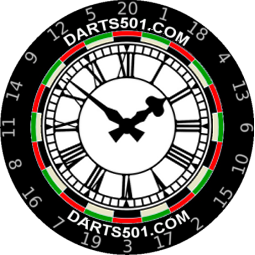
Around the Clock
Players: Two Players
Darts: Three each
Rules:
(Also see Around the World). The object of this popular game is to be the first player to hit every number on the board from 1-20. The numbers must be hit in order, and players alternate after three throws. The player must hit each number in turn and cannot proceed to the next number until the number is hit. The winner is the player who hist all the numbers in order first
For added difficulty, include the outer and inner bullseye at the end of the sequence
180 Around the Clock
Game design David King
Players: One or more
Darts: Three each

Rules:
Many people play around the clock to help improve their accuracy on the board. Around the clock is also a good game for beginners as it focuses on different individual targets. But here is a variation which I call 180! Around the clock.
First of all, this game or practice game is not about scoring 180s. It is about practising trebles around the board. The game can also be played against an opponent or on your own.
Rules
You throw three darts at each number in turn, aiming for the treble, i.e. 3 darts at treble one. If you hit a single one, you score 1 point if you hit a treble, you score 3 points. The most you can score in any throw is 9 points by hitting three treble ones. Hitting a double, but are considered as a poor throw and only score 1 point.
Regardless if you hit a single or treble, you move to the next number, in this case, number two and repeat the feat. A single two scores 1 point, and treble scores your 3 points. You continue around the board until you have completed all twenty numbers and then add your total. If you throw three trebles on each throw, you will score 180 hence the name!
If you are playing this game by yourself, I suggest you set a target, i.e. 60 points. You only need to hit three singles in each number to achieve this target number. If you are a regular player, set this target higher I suggest 75 – 80. Alternatively, keep a running total of your scores and aim to better the score the next time you play. You will be surprised how this basic game will improve your overall game and become addictive as you try to improve your score.
Remember, doubles are considered a poor throw in this game should you hit only score 1 point for these should you hit one.
Performance Guide:
- 20 Very poor, only hitting one with every three darts
- 30+ Poor – keep practising
- 40+ You may make the Pub C team
- 50+ You may make the Pub B Team
- 60+ Average requires three darts in each number
- 70+ Regular Player
- 80+ Good Pub Player
- 90+ Town Team Player
- 100+ County Player
- 120+ Professional
- 140+ World Champion
- 180 I don't think anyone will ever manage this feat, not even the great Phil 'The Power' Taylor
Playing as a Game?
If you play the 180 as a game against friends, then you can add an extra dimension to it.
One hundred eighty can be played with two or more players, but this extra dimension can spice the game up a bit more.*
* If a player fails to score on a number in a round of three darts, their score becomes frozen, and they proceed no further. Other players continue until 20 or until they miss a number and become frozen. The highest total wins.

Baseball
Players: Min Two Players or Two Teams
Darts: Three each
Rules:
Baseball is a simple and fun game that several players or teams can play. This version is played on a Standard Dartboard or, as some still call it a Lond Clock Dartboard.
The Object:
The game's object is simple: score the most runs in each innings. The highest score at the end of the game is the winner.
The Scoring:
The numbers 1 through 9 are written in ascending order on the left side of the scoreboard, and a total is added to the end. All players' names are written in batting order across the top (batting order may be determined anyway, usually one dart each at bullseye with the closest throwing first and the furthest last). A grid may be drawn around the numbers and the names for easier reading.
Innings |
Dave |
Sue |
Janet |
Graham |
1 |
||||
2 |
||||
3 |
||||
4 |
||||
5 |
||||
6 |
||||
7 |
||||
8 |
||||
9 |
||||
Total |
The Play:
Each player in order throws three darts at the number of the current inning. The target is 1's in the first inning, 2's in the second, etc. Each number only counts in that actual inning. For example, if a four is hit in the first inning, it does not count. The thin outer "doubles" ring counts as two runs, the thin inner "triple" ring counts as three runs, and the other sections of that number count as one. Therefore, the highest attainable score in any one inning is nine.
The number of runs scored is NOT multiplied by the inning number. For example, in the second inning, two single 2's and a double two are scored; that player's score would be four for that inning.
Usually, a running total is kept with the current inning's score being added to the current total. This way, players can see how far ahead or behind they are and can save a lot of time not having to add all nine innings at the end of the game.
If there is a tie at the end of the ninth inning, extra innings are played with bullseyes as the target. Extra innings continue until after all players have thrown for that inning, and no tie exists.
*Baseball Variation – '7th Innings Catch'
To add interest, a further version is the '7th Inning Catch'. This variation states that players who do not score any runs in the seventh inning have their score cut in half. This puts a little more pressure on the seventh inning than any other and also gives a player who is far behind a chance to catch up.
Battleships & Battleship Darts my version
Players: Two Players
Darts: Three each
Rules:
Only people of a certain age will remember the pen-and-paper game where you try to sink your opponent's fleet before they sink you. This variation uses a dartboard as the target area rather than the number/letter grid used in the original game. There are variations to this game, but here is one set of basic rules.
A reminder of the pen-and-paper game
As a quick reminder of the pen-and-paper game, two grids are drawn, usually 10 x 10. Numbers 1-10 are the columns and features across the top, and A-J are the rows to the left (see diagram and Pen-n-Paper download)
Each player then places a fleet of ships in the following order.
The Aircraft carrier is represented by five A's in a straight line, one A in each box AAAAA
Frigate – FFFF
Cruiser – CCC
Destroyer x 2 DD, DD
Submarines x 3 S, S, S
These can be placed vertically or horizontally on the grid but may not overlap. The placement is done without your opponent knowing the locations. You then call out, in turn, a guide reference. Which you both mark on your sheet. Usually, use 'O' if you MISS and an X for a HIT.
Example: Player one calls a grid reference A4. The player marks this on their open grid as a reference for a call. Their opponent then states if the call hits or misses one of their fleet ships, subs by saying 'HIT' (they have hit a target) or 'MISS' If references miss a target. Some rules state that if a hit occurs, the player also announces what type of vessel is hit, but decide before you play. Their opponent marks the guide featuring their fleet, so they know what has been hit and what has been missed, and both players' grids can be compared after the game has finished. If you destroy/sink a vessel, then your opponent must say you have sunk an (Aircraft carrier, Frigate, Cruiser, Destroyer, Submarine, whichever one applies) the winner is the person who destroys all of their opponent's fleet. At this stage, both players show their sheets so both players can see no cheating has gone on.

If you wish to play the pen-and-paper version of this game, I have created an A4 download you can use to play.
Battleships - Darts Game
This is my version of Battleship Darts. Other versions exist, but this game is played similarly to the pen-and-paper version. Instead of a 10x10 grid, the dartboard number segments are used with some additional rules applied.
The dartboard has 82 scoring segments. It comprises 20 large singles (outer), 20 small singles (inner), 20 doubles, 20 trebles, and an inner and outer bullseye.
Your fleet must be arranged as follows, and you must not overlap any of the fleets using the same target areas
1 x Aircraft carrier - five adjacent large numbers (AAAAA)
1 x Frigate – (one number) the double, large single, treble and small single (FFFF)
1 x Cruiser – three adjacent trebles (CCC)
2 x Destroyers - each Destroyer two adjacent doubles (DD, DD)
3 x Submarines - each Sub marine one small single (S, S, S, S)
Use the Battleship Darts download to mark your fleet potions, remembering not to show your opponent the positions of your fleet. Use the letter code shown above to indicate each of your ships and subs as you would typically use in the paper version of the game.
(see example board)

The inner and outer bullseyes can not be used to place the fleet, as the inner bullseye is used as a radar identifier in this game.
Like a standard battleship game, each player takes turns, in this case, to throw at the board (use all three darts). Should a dart hit one of your opponent's fleet, your opponent must tell you which dart(s) have hit and or destroyed a vessel. Hitting the same area twice does not mean you sink two vessels, nor does it count as a repeated hit on the same vessel. Use your own blank printed dartboard to keep track of your throws.
Radar Identifier - Bullseye
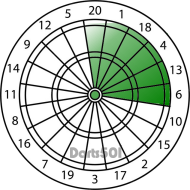 If your opponent hits the inner bullseye, you must give them ONE target area that contains part of a ship or sub. The radar Information can only be used once. So, multiple hits doesn't render more information. Once hit, it becomes a dead space.
If your opponent hits the inner bullseye, you must give them ONE target area that contains part of a ship or sub. The radar Information can only be used once. So, multiple hits doesn't render more information. Once hit, it becomes a dead space.
The winner is the person who sinks their opponent's fleet.

Chase the Dragon
Game design David King
Players: Two Players or more
Darts: Three each
Rules:
This game aims to hit the treble segments from 10-20 then the outer Bullseye and inner Bullseye in that order. This is a straightforward and fast game. The trebles that are used are the most hit in a combination out-shot in a game of 501. Therefore, it also helps with your accuracy with these common trebles. The winner of the game is the first to hit all twelve scoring areas in order.
This game has proved very popular amongst players and has been reproduced on some of my other websites,
Other standard rules apply three darts to each player, and throw consists of throwing all three darts if needed. Players take it in turn to throw.
A variation of this game is the three-headed Dragon. This game is won when you have completed the primary Dragon three times. It extends the game giving more opportunity to come back at a player that may have an early lead.
Cricket
Players: Can be played with 2 or teams
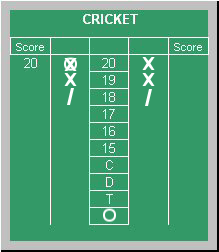
Darts: Three each
Rules:
Cricket is widely played around the globe but is a prominent feature in the USA, Japan and anywhere where there is a soft-tip dartboard. The game also forms part of the Soft-tip tournaments along with '01 games. In some US States, Cricket is played more than '01.
The objective is to 'own' or 'close' certain numbers on the dartboard and to achieve the highest point score. The player or team to do so first shall be the winner.
Cricket is played using the numbers 20, 19, 18, 17, 16, 15 and the inner and outer bullseye.
Each player or team shall take turns in throwing. (Three darts in succession shall constitute a 'turn'.)
The player or team must score three of a number to close a scoring segment. This can be accomplished with three singles, a single, a double, or a triple.
Once a player or team scores three of a number, it is 'owned' by that player or team, and they can score on this number 'runs' until the opposing player or team has also 'closed' it, and no further scoring can be accomplished on that number by either player or team.
To close the bullseye, the outer bullseye counts as a single, and the inner bull counts as a double.
Numbers can be 'owned' or 'closed' in any order the individual player/team desires. Calling your shot is not required.
'Owning' a number, the double and triple ring shall count as 2 or 3, respectively. Three marks will close the segment.

After a team owns a number, the double and triple rings shall count as 2 or 3 times the numerical values.
Winning the game:
The player or team that closes all scoring segments first and has the most points shall be declared the winner.
If both sides are tied on points or have no points, the first player or team to close all innings shall be the winner.
If a player or team closes all scoring segments first and is behind in points, he or they must continue to score on any innings not closed until either the point deficit is made up or until the opponent has closed all innings.
The player shall be responsible for verifying his score before removing his darts from the board. The score remains as written if one or more darts have been removed from the board. In accordance with the inherent "strategy" involved in the Cricket game, no alterations in score shall be allowed after the fact.
Cricket (Wickets & Runs) English

Players: Can be played with 2 or teams
Darts: Three each
Rules:
There are several variations of the game of Cricket. The game played mainly in America / Japan and on Soft-tip dartboards is different from the English version, also called Wickets and Runs. The English version of Cricket is based on the Cricket game where a bat, ball and stumps are used. The other version of Cricket (which is more widely played can also be found on this darts games page.
A Standard English version of Cricket.
Like the traditional bat and ball game, this game has a batter and a bowler. The batter starts with 11 wickets; this game's object is to score runs before you are bowled out. This game is bet played with two teams, each taking it in turn to throw.
A thrower from each side throws a single dart for the bull to determine who bats and who bowls. The nearest to the bull decides if they wish to bat or bowl first.
Rules & Scoring
Bowler
The bowler throws first, and their target is to hit the inner or outer bullseye, the 'wicket'. The inner bull is worth two wickets, and the outer, one. The object of the bowler is to bowl out the batter by hitting a total of 11 wickets. Once 11 wickets have been hit, the batter can no longer score, and the roles are reversed.
Batter
The batter scores points or runs on every throw over 40. if their score is less than 40, the score is not counted. Should the batter hit an inner or outer bullseye in the process of batting, they will lose a wicket(s) to that value.
Innings
Normally the game is played over two innings, i.e. both sides bat and bowl twice. The winner of the combined innings is the side that scores the most.
Like all good games, there are many variations. Here are a few:
Cricket Variation
- You can apply any of the following rules to make the game easier or harder.
- The batter's score counts on every throw and doesn't have to score over 40 to be recorded.
- Bowler Bounce outs or missing the board - can be recorded as 50 runs to the batting team.
- Batter Bounce outs or missing the board – can be recorded as a lost wicket.
- Bowler throws for the bull, and the dart lands outside the treble ring. The number hit is recorded as a wide, and the value hit is awarded as runs to the batting side.
- The batter scoring target is reduced to the area of the board that covers the double, large single and treble. If a dart is thrown into the small single, it either does not count, or a wicket is lost.
- Teams can nominate batters and bowlers.
- I am sure there are more variations of this great game, and if you have your own version, why not send me the detail for inclusion?
Hare and Hounds

Players: Two or more
Darts: Three each
Rules:
It is a basic game designed for players new to the sport looking for a game to help them throw. Also a fun game for children.
Players toss a coin or the nearest bullseye (single dart) to begin the game.
The player that wins the toss or is the nearest to the bullseye is the "hare," and their opponent is the hound in pursuit. The hare must travel clockwise around the board starting at 20. Unlike the game ‘Around The Clock’, you hit the numbers as the dartboard dictates.
20, 1, 18, 4, 13, 6, 10, 15, 2, 17, 3, 19, 7, 16, 8, 11, 14, 9, 12, 5
The hare wins by returning to 20 before the hound catches up with him. Depending on the players ' preference, the hound usually starts from either 12 or 5. The hound wins by overtaking the hare in the pursuit to complete a circuit of the dartboard. If the hound passes the hare, the game is over.
Variation / Addition
- You can record the distance the hare travelled so when the roles are reversed, you can see which hare travels futurist.
Halve-it

Players: Two or more
Darts: Three each
Rules:
To start the game, select any six numbers scoring numbers that feature on the dartboard. These can be single numbers, i.e. 20,19,18,17, Double 17, Double 9, Treble 7, Triple 11, Bullesye or Outer-Bullseye, or as in the example below, the Bullseye and Outer-Bullseye can be used as one scoring area.
Write the selected numbers/scoring segments in a column, adding a further line, ‘Total’, at the bottom. Now add further columns, one each, to represent each player. An example is shown below. It is probably best you draw out a grid as this will help score the game.
| Target | Player 1 |
Player 2 |
Player 3 |
Player 4 |
| Single 20 | ||||
| Double 16 | ||||
| Single 14 | ||||
| Treble 18 | ||||
| Single 16 | ||||
| Single 6 | ||||
| 25 or Bullseye | ||||
| Total |
The player throwing first must aim at the first listed number, in this example, ‘20’ for each dart hitting SINGLE 20, they score that amount, for example: if the player throws triple 20, Single 20, Single 20, they score 40 points, and this amount is placed in throw one under the players name. Player two then has their shot, and so on.
In the next round, the players throw for the following number/target listed: Single 15. However, if the player fails to hit and score anything on 15, then the score they have accumulated is halved. If the player scores 15, the score achieved is added to the score in the first round and written next to throw two (Single 15). After all, players have thrown the six selected numbers, the player with the highest score left is the winner.
(The above chart is only a guide any numbers can be chosen for the game.)
Fives
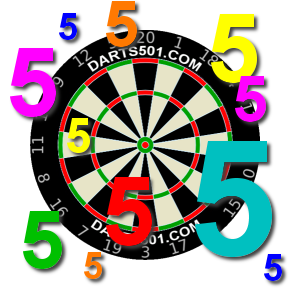
Players: This game can be played with any number of players.
Darts: Three each
Rules:
A total target number is first chosen; usually, 50 or 100 use a lower number if a lot of people are playing.
Nearest, the bullseye throws first, the furthest last.
The objective of this game is to score the highest number you can with each three-dart throw. The score you achieve is then divided by five, and that becomes your score! i.e., throw-score 60 / 5 = 12. However, should the throw-score a number not be divisible by five to leave a whole number, you score zero.
Trebles and Doubles are not counted. However, they are considered as part of the throw.
If you miss the board or have an unfortunate bounce out with one or more darts, you again score zero. This rule is to stop the deliberate miss. i.e. a play hitting 20, 20, and then a one would not score. Hence they might think missing the board with their third dart might be the best option. But not in this game!
Variation
- Doubles and trebles are not counted in this game. But generally, you are not penalised for hitting one. You can, however, make the game more interesting by making the treble and double foul shots, and the player doesn’t score on their turn should they hit one.
The first player to achieve the chosen target number is the winner.
Follow On / Follow the Leader
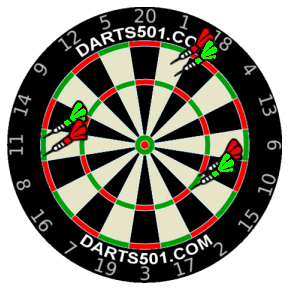
Players: This game can be played with any number of players, more the better.
Darts: Three each
Rules:
An easy and fun game to play with multi-players.
The object of this game is to hit the target the previous player threw and then set a new target for the next player to hit! The winner is the last person left.
How to play
Nearest the bull determines the order of play. Nearest, the bull throws first and the furthest last. Once the order of play has been determined, the players’ names are recorded in that order of play and three lives are then shown next to the name.
Player one (the person nearest the bull) uses their non-throwing hand to throw a dart into the dartboard. i.e. if the player typically throws right-handed, their use their left and vice-versa if they are left-handed. Where this dart hits becomes the first scoring area and the first target for the second player to throw for.
Example
If the opening throw hits a single 16 in the segment between the triple and the bullseye, this is known as a small 16, i.e. the smallest area of the 16. The following player must hit the small 16 area within a three-dart throw. Other parts of the 16, i.e. the double, the large single or treble, do not count as hitting the target.
If the following player fails to hit the small 16, they lose a life, and play continues to the next player.
Should the Payer hit the target area with one of their first two darts, they can set a new target area with their third (normal throwing hand). Should all players miss the target set and the play returns to the player who set the target. They can either pass on their throw or try to hit it and set a new target. (best to pass!)
If they have two darts in hand, they can use one or two darts to set the new target area. The last dart used is the counting dart, and it must hit the scoring area of the board, or the player loses a life!
With two darts in hand, the player might want to set a challenging target, maybe a double. They may opt to use their second dart in hand if they miss the number and hit a big single or indeed miss the board. If the first dart lands nicely in an area they believe will be difficult for others to hit, they may choose to declare that as the new target area. The player may not choose to throw both darts and then opt for where the first dart fell.
If the target area was hit on the third dart, then the player has all three darts (if they wish) to set a new target area. They may stop after their first or second throw or continue with the third. They may wish to throw for a double, but they must set a new scoring area; otherwise, the previous target area remains.
The player left with one or more lives intact is the winner.
Variations
- The commonly played due to the nature of the scoring rings is a similar game, Loop / Loopy.
Football

Players: A game for two players.
Darts: Three each
A straightforward game given the title of Football but has little to do with Football or Soccer, as some call it. Pretty Basic, but at least you don’t need to learn the offside rule for this game!
The game, however, may help you improve your double scoring.
Rules
Nearest the bullseye throws first
The first player that hits a ‘bullseye’ proceeds to throw for any doubles. For each double that is hit, they score a goal. The second player also throws for doubles after they have also hit a ‘bullseye’. If you wish, you can accept two outer bullseyes hit instead of a single bullseye, but only if this is agreed upon prior to the start of the game. Both players must hit either of these before commencing the doubles. The player who scores ten goals or ten doubles is the winner.
A player can score on the same double more than once or continue to score bullseyes as these count as double 25.
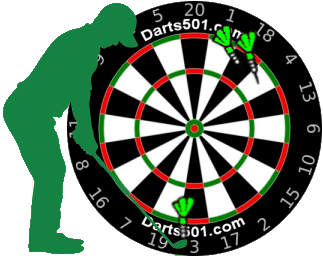 Darts Golf
Darts Golf
A lot of Dart games have been influenced by other games, and 'Darts Golf' is no exception. There are also dartboards designed purely to play GOLF, but here is aversion you can play on a standard dartboard.
Rules
The rules and game are pretty simple. The scoring segments 1-18 on the dartboard represent the 18 holes found on a golf course. Each player must score three of each number in turn before progressing to the next 'hole' (number).
Scoring equates to 'strokes' taken for each hole. Hitting a treble counts as a hole-in-one. A double or singles both score one. If you miss the segment with a throw, this also counts as a stroke. So, two misses, followed by three single hits, count as five strokes.
A player stays on the number until they hit three of the number, regardless of how many darts it takes to achieve this feat. The winner is the player with the lowest number total score to hit all 18 segments this way.
This game also allows you to handicap good players and allow for extra strokes for new players!
The lowest number of darts to achieve this feat is 18, hitting a treble with each dart. The normal 'Par' for the course is 54, i.e. three single darts in each single segment.
A good game player may regularly hit a few holes in one's! Hence the game can be played with the amount over or under 'Par' or adjusted 'Par'.
Example: If a player is likely to hit a few (3) hole-in-ones, the 'Par' for the course for this player moves from 54 to 48! A new darts player might be given an extra stroke or dart at each hole, i.e. moving their 'Par' to 72, making the game between a good player and a new player a little more even.
How to determine a handicap
Play a few rounds of darts without handicaps. However, all plays must finish the entire course. Add the total number of darts taken over the few rounds and divide by three.
If your average is:
Above 72 then you play off Par 72
64 - 72, Par 64
58 - 63, Par 58
54 - 58, Course Par 54
48 - 53, Par 48
Adjust to give the best fit. Use additional games' total stroke scores to vary your Par / Handicap.
Enjoy!
Grand National
Game design David King
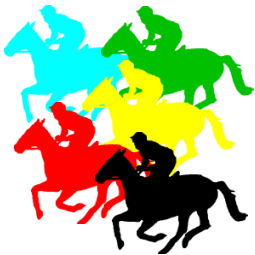
Players: More the Better
Darts: Three each
Rules:
Loads of games can be played on the dartboard, and here is another. Similar to Steple Chase but with a difference and a degree of difficulty and based on the 'Grand National' horse race.
The origins of this game.
Grand National Day! Many of the pub punters had a small flutter on the gee-gees and a few drinks to go with it. The pub dartboard was occupied by punters that could play at a basic level. So I thought with a big gathering it would be a good idea to gain a few more converts to a wonderful sport of darts. Hence, the game was born!
This game is based on the horse race, the Grand National, and over the years, it has developed a bit, so here are the basic rules that I suggest are played by a novice player, followed by a revised version for the more experienced dart thrower.
The Grand National is probably the World's most-known horse race. The race twice around the circuit jumping fences. The first home is the winner! The trouble is most fall!
The basic darts game based on the Grand National is straightforward to play, but a varying degree of difficulty can be added. The basic game for the novice' new' to darts follows this format.
Rules
Novice Game
Each player has three darts, and the object is to travel around the dartboard anticlockwise starting at 20, then 5, then 12, etc. Each segment is known as a hurdle. In the novice game, you must hit at least one segment with each turn (3 darts), i.e. start at 20, you must hit it; if not, you fall at the hurdle and are out of the game. Hitting 20, you move to the next segment and so on first around and back to 20 wins!
The rules here for the novice are very simple, and after a few drinks, you won't be surprised to see a few complete during the race.
The Dart throwers version
For a competent dart player, this will be very easy and probably not as inspiring as I would expect each segment to be hit with a single dart. So here is a slightly harder version.
For the more experienced player, the Grand National is played in the following way. Again the objective is to travel anticlockwise around the board twice, but this time you start at the large 5 segment, (the light segment) of the board. You then have to move around the board, hitting each alternative large segment number i.e. 5, then 9 followed by 11, until you reach 1. The second time around the board, you must hit the small segment of the five and the small segments of each alternative number and then a final Bull / 25 representing the finishing post. The dark segments represent the hurdles or fences.
The players here also have three lives, but you can vary this to suit the ability of the players. Here life is lost if you miss the segment with a single dart. The winner is the first to travel around the board twice or the furthest travelled.
Killer / Blind Killer

Players: Best Played with 5 People Plus
Darts: Three each
Killer:
Killer is a good game when you have a crowd of people wanting to use the board at the same time. There are a couple of variations to this game, but basically, the rules are the same.
Rules
Firstly each player draws lots, i.e. a number between 1 - 20. This is done by writing the numbers down on individual pieces of paper, and then the numbers are drawn blindly.
The names of each player are recorded on the chalkboard or Marking Board along with their number. Each player is then given between 3 & 5 lives. The objective of this game is for each thrower to first hit their own number's double three times to gain the status of KILLER. Once they have achieved this, they can throw for their opponent's number doubles in any order they wish. Every time a KILLER status player hits an opponent's double, their opponent loses a life.
KILLERS can also commit SUICIDE. If they accidentally hit their own double once they have gained the status of KILLER, they will also lose a life. Once all your lives have gone, you are out - the winner being the only player left alive!
Blind Killer:
Blind Killer is slightly different. Firstly you draw your number, but it is not shown to anyone in this case! The numbers 1 – 20 are recorded on the chalkboard/Marking Board. Then each player then takes it, in turn, to throw for any double, and if one is hit, it is recorded next to the chalked number. Once a double has been hit three times, the person with that number is eliminated.
Experienced players of this game will know the odd missed attempt at their own number can mislead others.
If you have one good player in the group, then it is natural to try and eliminate the good player first. This is easy to do in the standard Killer game because you know what number they are on. Hence Blind Killer can help the better player, but it doesn't mean the better player always wins.
The winner of this game is the player that remains alive.
Knockout
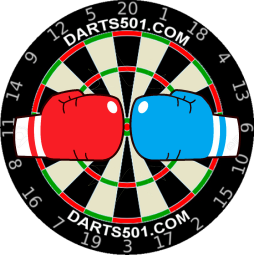
Players: Best played with 2 - 8 Players
Darts: Three each
Rules
The player’s order of play is determined by throwing a single dart each, nearest and furthest from the Bullseye determines the order of play. Nearest first furthest last, write the names in order on your marking board.
The player selected to throw first must throw as many points as possible. Their score is then written alongside their name.
The player next in line must throw a higher score than the one thrown before them. If they fail to throw a higher score, a ring is put around their score. They drop out of the game once they have 3 rings next to their name.
Play continues in order until there is one player left in the game. The object is to better the highest score that has been achieved. The game is designed to improve players scoring. A good game for match warm-up nights.
Loop or Loopy!

Players: Two or more
Darts: Three each
As the Game suggests, this is a Loopy game in more ways than one!
This a game best played by several people. The object of this game is to follow the leader, but you don’t just use the traditional scoring area of the dartboard. You also use the wire numbering system of the board as well!
This game should be played cautiously and is unsuitable for some dartboards with moulded number rings. Unfortunately, having played this game a lot over many years, I have seen the number ring destroyed on several occasions. You have been warned!
Rules
Start by first throwing for the bull with a single dart, the nearest to the bull being the player who starts the game, followed by the second nearest and so on, the furthest away being the last player to throw. The order of play is now established, and the players' names are recorded on the marking board along with 3 – 5 lives for each player.
The first player throws for the board! This can be any part of the board, including the loops of the number wiring system and split numbers. If the first dart lands within any of these areas, the following player must hit the same space with his three darts before throwing for another area. If they miss, they lose a life! If the player fails to establish a new target, the previous target remains.
Example
If the first player hits the big area of number 1, then with his first dart, the second player must hit the same area before throwing for another sector. Hitting double one, treble one or the smaller inner area of one in this instant does not count; the large area must be hit.
If the following dart thrower hits the numbered sector, then they can use the remaining darts to establish a new target for the next player. The next scoring dart counts as the new target. They forfeit a life if the player fails to score with the remaining darts.
As the Game entails, the numbered wiring system comes into play, so numbers 4,6,8,10,14,16,18 & 20 all have loops!!! If a player throws a dart into the loop of number 6, then that becomes the target area. Also, a number of numbers can be split;11,12,13,14,15,16,17,18,19 & 20. If a dart is thrown between the two 1’s of 11 this effectively splits the 11, and this becomes the new target area. The numbers 8 and 18 effectively have two loops these are known as the higher and lower loops. Each of these loops is effectively its own potential target area.
The only area you cannot score on is the area effectively between the edge of the standard board scoring area and the numbers. If you hit this area or your dart bounces out, then you do not score.
The winner of this Game is the player that remains alive!
Mickey Mouse

Players: Two Players or Two Teams
Darts: Three each
Rules:
Mickey Mouse is a very simplified version of Cricket / American Cricket without scoring, plus additional twist.
Rules
The object of the game is to "close" all your numbers (20 down through 12, any three doubles, any three trebles and the bullseye. To close a number, you must hit three of that number.
The Scoring:
The scoreboard is drawn with the numbers 20 through 12, doubles, trebles and bulls written in descending order down the centre of the board. The Bull eye is usually abbreviated with a B. Doubles with a D, and Trebles with a T.
Each dart that lands in any of the game's numbers counts toward closing that number. The thin outer ring counts as two of that number or counts as one double. The thin inner ring counts as three of that number or counts as treble. Scoring for one dart is shown by placing an ( X ) next to the number scored. Scoring for two is shown by placing an additional X (X X) next to the number scored. Scoring for three is shown by placing a third X (XXX) next to the number to indicate it is closed. It is closed when three of a number is scored in any combination.
If a player hits a double or treble of a scoring number, they can choose between marking it as a double or treble or counting it as two / three singles on the scoring number they hit.
E.g. Hit treble thirteen. This can either close treble thirteen or count as one treble closure.
The players each take a turn, throwing one dart at the bullseye. The closest dart to the bullseye gets to throw first. The first player throws three darts at any of the scoring numbers to close. Play alternates until one person closes all their numbers.
A more interesting version of 'Mickey Mouse' is played like standard American Cricket by scoring points on numbers that are not closed. You first have to hit each number three times, and then you can score on it until your opponent closes the number. Here, the highest score wins the game, not the first to close all the numbers.
Nine Lives

Players: Two Players or More
Darts: Three each
Rules:
This is a simple game of elimination for any number of players designed for the less experienced player. However, It does get a little long when there are a lot of players.
The Object:
To be the first player to get "around the clock", that is to get at least one dart in each number from 1 through 20 in order.
The Scoring:
Each player throws one dart at the bullseye; the closest to the bullseye goes first, and the furthest from the bullseye goes last. Each player gets three "lives" represented by three tally marks below their name. I don't know why the game is called 9 Lives, but you only get 3. Maybe it is because if you miss with three darts, you lose a life and 3 x 3 = 9! If you know any different, please let me know.
The player's names are recorded on a chalkboard or whiteboard along with three X's (XXX). Each player then takes a turn, trying to hit each number from 1 through 20. The numbers must be hit in order, or they do not count.
If a player misses with all three darts, one life is lost, and an X is removed from that player. When all three of a player's lives are lost, that player is out of the game.
Noughts and Crosses (OXO)

Players: Can be played with 2 or teams
Darts: Three each
Rules:
Noughts and Cross can be played between two players or two teams.
Rules
Draw a noughts and crosses / Tic-Tac-Toe grid of nine spaces, three by three, on a scoreboard or piece of paper. In the middle square, write Bullseye; in the other eight squares, write different one dart scoring numbers, i.e. Treble 9, small fourteen (the small single scoring segment of fourteen) , double two, etc. (see example below).
| Treble 9 | Small Thirteen | Treble 5 |
| Double 1 | Bullseye | Small 17 |
| Large 6 | Treble 7 | Double 2 |
One player or team aims to complete a straight line of three. Every time a target score is hit, the initials/team name or X / O is placed in the scoring square, replacing the figures. As with normal noughts and crosses, players aim to hinder their opponents to prevent them from getting three in a row.
| Treble 9 |
|
|
|
|
|
|
| Large 6 | Treble 7 |
|
The game can be made easier by using single numbers in eight of the nine squares.
Variation based on different skill levels
If two players have a significant skill level difference, you can make one set of targets more challenging to hit., for instance. Used single numbers for the less skilled and doubles of the same number for the experienced player.
Prisoner

Players: Best played with 5 people plus but can be played with 2
Darts: Three each
Prisoner darts game is best played with a group of players around the clock on the outer part of the dartboard. Miss and leave your dart in the dartboard. It is a prisoner of the board! Your opponent(s) can capture your dart, or you may be lucky to win it back!
Rules:
The object is to be the first to shoot "around the clock" one dart in each number from 1, clockwise, to 20.
Each player should throw one dart at the bullseye. The closest to the bullseye goes first, and the furthest goes last.
The first player tries to hit one dart into each number in order, starting with the number 1, but the scoring target is only from the triple ring to the double ring. (triple and double included)
After number 1 is hit in the playable area, the next target is 18 and so on, clockwise around the board.
If the player's dart misses the board (outside the doubles ring) or bounces out, the dart is left on the board for one turn. The player throws only two darts the next turn and may pull the lost dart for use in the next turn.
Now for the Prisoner part: If the player throws a dart into the area from the bullseye to the triples ring (inner bullseye and outer bullseye included), the dart is left in the board and is a "Prisoner". A prisoner dart remains on the board until any player (including the player who threw the dart) hits the playable area of the same number (in the case of the bullseye, hitting another bullseye captures the prisoner). Once a player captures a "prisoner", the dart is theirs to use for the rest of the game (unless it is lost similarly).
If there is more than one "prisoner" dart that may be captured, they may only be captured one at a time. For example, two darts in the small 18 between the bullseye and the triple ring must be thrown into the playable area 18 to capture them both.
After the first "prisoner" is captured, one player will have four darts to use, while the player who lost the dart has only two. By the end of the game, you might be playing with seven darts, and none of them might be yours!
Play continues until one player has thrown a dart at every number from 1 through 20 in the target area. The first player to do this wins the game. It sounds crazy, but it can be a lot of fun.
Scam
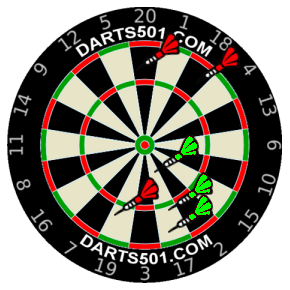
Players: A game for two players.
Darts: Three each
One player is known as the ‘stopper’, and the other is the ‘scorer.’ The stopper must try to prevent the scorer from scoring by first getting their darts into the number’s segments. The bullseye and outer bullseye are not used in this game.
Rules
Players throw for the bull to decide which one starts. The throw winner commences as the ‘stopper’ and throws first, aiming to get the three highest possible numbers. For each number that is hit becomes out of play for the ‘scorer’. The ‘Scorer’ must aim for the next highest number available to score the highest amount. The play continues until the ‘stopper’ has hit all the numbers on the board, 20-1. Once this has been done, the score is added up, and the play reverses. The ‘Stopper’ becomes the ‘Scorer’, and the ‘Scorer’ now becomes the ‘Stopper’. The winner is the player with the highest score.
Variation of the game is Brag
A variation of this game known as ‘Brag’ can be used with a small wager. The ‘Scorer’ has to nominate a score they will achieve before any darts are thrown. The ‘Stopper’, if he or she believes they can prevent such a score from being achieved, can have a wager/bet on the outcome.
Shanghai

Players: Two or more
Darts: Three each
Rules:
Either use a toss of a coin to see who begins play, with the winning player going first or nearest and further from the bullseye method. Players start by throwing at the number 1 on the board. The object is to hit a single, treble and double (in any order). This first player to hit a single, treble and double wins. If no player achieves this on number 1, the play moves to number 2, then 3 ….. until someone wins.
Shove Ha'penny

The game Shove Ha'penny is a game that has been played in British Pubs since 1840, and the traditional game is played on a polished board using coins. But like many games like this, a version has been designed for the dartboard.
A variation of this darts game is not new and dates back as early as the 1930s or earlier, but like Shove Ha'penny, the polished board game, it is not played as often as it should. In the 1970s (1972-1977), Yorkshire TV broadcasted an event featuring pub games such as darts, pool, bar billiards, table skittles, arm wrestling, table football, and Shove Ha'penny. Of all the pub games shown in this program, Darts was a clear winner with viewers, and the rest is history.
Shove Ha'penny Darts Rules
Any good dart player can play the game, but it does require good judgement and a keen eye.
In this game, the dartboard segments Numbered 1, 2, 3, 4, 5, 6, 7, 8, 9, and centre. In this case, the inner and outer bullseye are counted the same. The remaining segments of the dartboard are considered dead and have no scoring value.
Any number of people can play the game, but it is best played with only two or four. Each player takes it in turn to throw three darts; the object of the game is to get three darts in each of the ten scoring segments mentioned above. Whoever manages this feat first is the winner!
First, determine who to throw first, either with a single dart nearest the bullseye or a coin toss. Then, list the number in a column on a chalkboard or whiteboard. Along the top are the names of the players.
However, unlike most dart games, the order in which you achieve this feat doesn't matter. A player can throw a one, two, and six with their first throw, and they all count. But the game isn't as simple as that. If a player has previously thrown three of their darts in one of the scoring segments in the game and then accidentally hits the segment again, then this dart counts for a point to another player that requires a point to help 'close' the segment. One stray dart could cost you the game!
Snooker
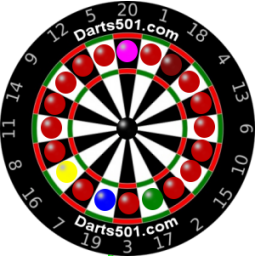
Players: Two or Two Teams
Darts: one each
Snooker darts follow similar rules to those laid down in Snooker. However, the dartboard segments represent the colour of the balls.
Rules
To commence the game, each player throws one dart at the Bullseye; the nearest to the Bullseye has the first shot (the break).
Break
The player breaking then must throw a number between 1 – 15 as these are counted as a red ball. If they cannot throw a number between 1 - 15, and miss the dartboard playing area, the next player has a turn. However, they score one point if they hit one of the red balls 1-15. The red / number they hit is then deemed pocketed, as in Snooker, and can not be used again for further break building.
Once a red has been pocketed, the player has to nominate a high-value colour, 16-bullseye, before throwing for it to build their break. The Bullseye represents the black ball, and the inner and outer Bullseye count in this game.
After hitting a red, the player may nominate a pink (the twenty-section) worth 6 points. If they hit it, the player continues with their break, hitting another available red and then nominated high-value colour. As in Snooker, the same high-value colour can be used as this is back in play, unlike the pocketed red9s). The player may retrieve their three darts after all are thrown or when their break ends.
1 - 15 Red |
1 point |
16 Yellow |
2 points |
17 Green |
3 points |
18 Brown |
4 points |
19 Blue |
5 points |
20 Pink |
6 points |
Bullseye Black |
7 points |
Foul throws
If a player misses the scoring area or lands a dart in a previously pocketed ball area, it is the end of the break and no foul is awarded.
If a player is throwing for a red or low-value colour, i.e., yellow, green, brown and hits another colour, four points are awarded to their opponent, and their break throw is over. However, should they hit a higher value colour, blue, pink, or black, then the value of the colour they hit is awarded to their opponent: Blue 5, Pink 6, and Black 7.
Should the player be building a break and miss their nominated colour and hit another, the value of the colour they were throwing for or hit is awarded to their opponent, whichever is greatest. Break points to this point are kept.
Reds / Colours
There are fifteen reds; once they are pocketed, the colours must be pocketed in order.
Yellow 2 points, Green 3 points, Brown 4 points, Blue 5 points, Pink 6 points and black 7
The game is won when all the balls are pocketed. The player with the highest total of combined breaks is the winner
This game is relatively easy and best suited to new players. Experienced players may find this game a bit too easy.
Sudden Death

This is a multiplayer game and suitable for pre-match team warm-up.
Rules
This game is quick and very simple to play. Each player has three darts to score as much as they can. The scores are recorded, and the lowest-scoring player is eliminated.
The remaining players throw again, and the lowest-scoring player again is eliminated. You continue to play until only one player is remains who is declared the winner.
Game Variations
If there are only five players, you can consider having two rounds each. i.e. player one throws three darts, and their score is recorded. Once all players have thrown, nobody is eliminated. Player one then throws their second set of three darts, adding this score to their first throw. When all players have thrown twice, and their total scores are counted, the player with the lowest score is eliminated.
Another variation, again only used if there are a small number of players, is to give each player three lives. They played as before, and the loser of each round loses a life. When they have lost all their lives, they are then eliminated. The winner, as before, is the last player standing.
The Preston Game

My thanks to to my friend Barry Riley for providing the details of the 'Preston' Game and for allowing its inclusion on my dart websites.
The Preston Game & Dartboard
This game was given to me 'as played on a Preston Dartboard!' Hence, the Preston Game may well be known as something else.
What is or was a Preston Dartboard, I hear you say? The Preston board was made of clay/plasticine, and in Preston, Lancashire, the board was referred to as the Preston dartboard. However, for those who can remember, it was just a clay/plasticine dartboard of a London Clock design. Today, the clay dartboard is consigned to history. However, you can play the game on a standard sisal London Clock board.
Rules
The game is rather basic. It's like around the clock with added Manchester dartboard rules. It is a race twice around the dartboard and then hit two double-tops / double 20s to finish. The player hits the numbers in order 1-20 and then continues for a second round the time around the board but must finish by hitting two double 20s, although the double 20s do not have to be hit in the same throw.
Like the Manchester dartboard rules, hitting a double of a number while travelling around the board can promote you to the number higher than you have just hit.
Example: Should you require the number seven and hit a double seven (14), you jump to the number 15; however, hitting a double 15 cannot promote you further because the highest number on the board is 20.
Trebles and bullseyes are meaningless in this game. Hitting a treble counts as a single, although some may say that isn't a single, and the dart doesn't count. Agree on the ruling here before you play! The winner is the first to go around the dartboard twice and then hit two double 20s!
Tennis
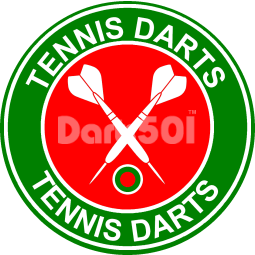
I thank Richard Cotterill and Keith Block for designing this game and sending it to me for inclusion on my dart websites.
Two players play tennis (although four could be involved as pairs).
The following describes a game that should take about 25 minutes “(A)”. The longer game “(B)” can take 55 minutes or more.
The object of the game
(A) To win a “Set” - the best of 6 service games. If the service game score reaches 3 - 3, the ‘Set Tiebreak’ is played.
(B) To win a “Set” - the first to 6 service games, provided the winning margin is at least two service games (i.e. 6 - 4 or 7 - 5). The' Set Tiebreak' is played if the service game score reaches 6 - 6.
The Play
Each player throws a dart at the bullseye. The closest throws first and is the “server” for the first game (as well as the ‘Set Tiebreak’ if there is one).
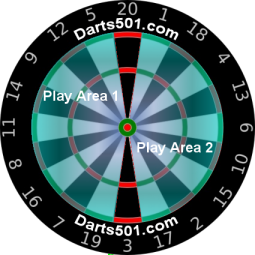
On a chalkboard/whiteboard, write the players’ names as headings and leave a space underneath for “Score”, “Games” and “Tiebreak.” (if you put a mark by the name of who is currently “serving” it helps the memory!). On an electric scoreboard, use it as you would for a standard straight-in-double-out game with a tally of (A) 91, which is 15+30+40+1+2+3 (B) 114, which is 15+30+40+1+2+3+4+5+6+7.
Each service game starts with the “play area” on the left-hand side of the dartboard (i.e. 5 to 19 inclusive) and changes to the right-hand side (i.e. 1 to 17 inclusive) for the next point. The “play area” alternates between the two during a service game.
The “server” has to hit a number in the “play area” with one of their first two darts. If they don’t then the point goes to their opponent. The number that is first hit by the “server” is the “target number”.
If the “server’s” first dart hits a double, then an “ace” has been thrown, and the point is won. (Optional: add the 20 and 3 to the “play area” for the “ace” shot only.)
The “Rally”
If an “ace” or “double-fault” has not been thrown, then the “server” tries to hit as many of the “target number” as possible: a treble scores three, a double scores two and the remainder of the segment scores one. The “server” counts up their score and declares it (the “target score”) and the “target number” to their opponent (the “receiver”).
The “receiver” then throws at the “target number” to try and beat the “target score”.
If the “server’s” score is highest, the “server” wins the point.
If the “receiver’s” score is highest, the “receiver” wins the point.
If the players score the same, then the “server” throws again, setting a new “target score”.
This continues until someone wins the point.
Once the point has been won the “play area” changes and the “server” starts again.
Once the service game has been won, the players change roles from “server” to “receiver” and vice versa.
Scoring
To win a service game, a player must score 15, 30, 40 and “game” points. If the score reaches deuce (40 - 40) then the ‘Deuce Tiebreak’ is played. The points are won by:
(A) The “server” hitting a double with their very first dart (of each point) - an “ace”.
or
(B) A player hitting more of the “target number” than their opponent.
Deuce Tiebreak
This is played on the inner and outer bullseye. The aim is to hit as many as possible.
The “server” always throws first. If they hit a bullseye with their first dart, then an “ace” has been thrown, and the point is won.
The “server” counts up their score (a bullseye counts as two) and declares it (the “target score”) to their opponent (the “receiver”). The “receiver” now aims to beat the “target score”.
The player with the highest count wins the point.
If the players’ scores are the same, then the “server” throws again, setting a new “target score”.
This continues until someone wins the point.
The winner of the service game is the first to score three points.
Set Tiebreak
This is also played on the inner and outer bullseye. The aim is to hit as many as possible. The “server” of the very first service game throws first.
Except for the first point, each player serves for two consecutive points. Everything else is the same as in ‘Deuce Tiebreak’ above except that the winner of the “set” is the first to score.
(A) Three points.
(B) Seven points, provided the player is two points clear. Otherwise, play continues until a player is two points clear (it may be worthwhile considering a limit here . . . !)
Games that feature on this website
Some of the games on this website have been designed purely for inclusion on my websites. However, many have been played for many decades, and some date back as far back as the early 1900s. However, you may find some regional variations to my published rules.
Designed for my websites: 180 Around the Clock, Chase the Dragon, Grand National, plus Tennis, supplied by Richard Cotterill and Keith Block. Barry Riley supplied the ‘Preston’ Game. Please do not reproduce these games on your own website. If you like the games I feature, then, by all means, place a link to this page.
Should you supply a game for inclusion, and if it is accepted, a credit will be given to you as per the game Tennis and the ‘Preston’ Game.
If you have copied any ‘Designed for my website games’ and placed them on your website without gaining permission, please remove them. Thank you.
![]()
UK Regional Dartboard Games
Please note the height and throwing distance of the regional dartboard vary and may differ from the standard dartboard setup. Details of each are covered in the links below and again within the download and on the dartboard setup page. Enjoy!
Other Dartboards
Acknowledgements | Privacy, Cookies & Terms of Use | FAQ


